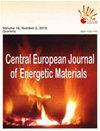Studies on the Effect of Nitrate Esters on the Properties of Advanced Energetic Propellants
IF 0.6
4区 工程技术
Q4 CHEMISTRY, APPLIED
引用次数: 1
Abstract
: Propulsion designers all over the world are exploring the possibility of achieving higher performance by enhancing the energy of solid propellants. This can be achieved by replacing non-energetic ingredients with energetic ones or by replacing low density ingredients, particularly binders, with higher density ones, without affecting the processibility and ageing characteristics. The same has been attempted by using nitroglycerine (NG) and butanetriol trinitrate (BTTN) as plasticizers in propellant compositions. In the present study, NG and BTTN have been used in different plasticizer to polymer ratios (Pl/Po) and various parameters of each composition have been theoretically predicted. Three propellant compositions plasticized with NG, BTTN and a 1:1 combination of NG and BTTN, have been processed and analyzed for targeted properties. From the theoretical data, it was observed that there is a negligible increase in density impulse beyond a Pl/Po of apart from the higher density and calorimetric values of the NG-plasticized propellant; these plasticizers have a significant effect on the ballistic and mechanical properties. Another observation was that the elongation of BTTN and NG/BTTN (1:1) plasticized propellants is significantly higher at a low crosshead rate than NG-plasticized propellant, implying that the two former propellants have higher strain capabilities at low temperatures and can be used for missiles having long term low temperature storage requirements. Thermal decomposition studies have been carried out by DSC, and for each composition 5 distinct peaks were observed.硝酸酯对高能推进剂性能影响的研究
世界各地的推进设计人员都在探索通过提高固体推进剂的能量来实现更高性能的可能性。这可以通过用含能成分代替非含能成分或用高密度成分代替低密度成分,特别是粘合剂来实现,而不会影响加工性能和老化特性。用硝酸甘油(NG)和三硝酸丁三醇(BTTN)作为推进剂组合物中的增塑剂,也进行了同样的尝试。在本研究中,NG和BTTN被用于不同的增塑剂与聚合物的比例(Pl/Po),并对每种组成的各种参数进行了理论预测。用NG、BTTN和NG与BTTN的1:1组合塑化了三种推进剂组合物,并对其目标性能进行了加工和分析。从理论数据可以观察到,除了ng塑化推进剂的密度和热量值较高外,密度脉冲的增加可以忽略不计,超过1 Pl/Po;这些增塑剂对弹道学和力学性能有显著影响。另一个观察结果是,BTTN和NG/BTTN(1:1)塑化推进剂的伸长率在低交叉头速率下明显高于NG塑化推进剂,这意味着前两种推进剂在低温下具有更高的应变能力,可以用于具有长期低温储存要求的导弹。通过DSC进行了热分解研究,对每种成分观察到5个不同的峰。
本文章由计算机程序翻译,如有差异,请以英文原文为准。
求助全文
约1分钟内获得全文
求助全文
来源期刊

Central European Journal of Energetic Materials
CHEMISTRY, APPLIED-ENGINEERING, CHEMICAL
CiteScore
1.80
自引率
25.00%
发文量
0
审稿时长
>12 weeks
期刊介绍:
CEJEM – the newest in Europe scientific journal on energetic materials It provides a forum for scientists interested in the exchange of practical and theoretical knowledge concerning energetic materials: propellants, explosives and pyrotechnics. The journal focuses in particular on the latest results of research on various problems of energetic materials.
Topics:
ignition, combustion and detonation phenomenon;
formulation, synthesis and processing;
analysis and thermal decomposition;
toxicological, environmental and safety aspects of energetic materials production, application, utilization and demilitarization;
molecular orbital calculations;
detonation properties and ballistics;
biotechnology and hazards testing
CEJEM presents original research and interesting reviews. Contributions are from experts in chemistry, physics and engineering from leading research centers in Europe, America and Asia. All submissions are independently refereed by Editorial Board members and by external referees chosen on international basis.
 求助内容:
求助内容: 应助结果提醒方式:
应助结果提醒方式:


